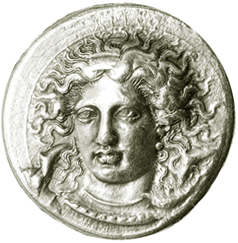...Best of Sicily presents... Best of Sicily Magazine. ... Dedicated to Sicilian art, culture, history, people, places and all things Sicilian. |
by Vincenzo Salerno | |||
Magazine Index Best of Sicily Arts & Culture Fashion Food & Wine History & Society About Us Travel Faqs Contact Map of Sicily
|
Arethusa, shown here on a Syracusan coin, was widely venerated in Greece and Sicily. According to the most popular version of the legend, she was a daughter of Nereus and Doris who passed her time in the retinue of Artemis (the Romans' Diana), goddess of the woods and the hunt. Herself a huntress, Arethusa vowed never to marry. One day, while bathing in a cool river, relaxing from a hunt, she was observed by the river god, Alpheus, who, in human form, fell in love with her. The long-lived, beautiful nymphs were usually associated with natural locations, such as streams, mountains or forests. Arethusa was a river nymph. Her myth originates geographically with the River Alpheius in the city state of Elis in the northwestern region of Peloponnese. Certain parts of this river, which empties into the Ionian Sea, pass underground. Fleeing Alpheus, Arethusa sought the protection of her patron, Artemis, who was widely worshipped in both Elis and Syracuse. Artemis transformed Arethusa into a spring that flowed beneath the Ionian Sea to emerge on the island of Ortygia in the Sicilian city of Syracuse (Siracusa), where the same spring can still be visited today. Alpheus followed her, and here their waters are said to mingle still. There are other versions of the myth. Ovid's Metamorphoses is the basis for this one, and he describes Alpheus as taking human form, at least originally. In view of the tradition and imagery of Greek myths, that would be appropriate to the story. Greek gods often assumed human form in their dealings with humans. In an earlier legend, however, Artemis herself was pursued by the river god, who she escaped by deception, disguising herself with mire (dark mossy mud). We may interpret this as implying that Artemis was previously desired by Alpheus and therefore understood his lust for the young nymph Arethusa. The message of the story, if one can be said to exist, involves more than lust, love or desire. It seems to say something about the close political and cultural links between Syracuse and certain regions of Greece at a time when alliances were often fickle. That some parts of the River Alpheius flow underground lends a certain "naturalistic" credibility to the tale.
It has been suggested that the Arethusa's underground spring feeds the mikvah of Syracuse in Ortygia's Jewish Quarter. For some eight centuries the legend of Arethusa survived as part of the fabric of Syracusan life, just as Persephone's cult endured at Enna in central Sicily. Their stories bear a striking similarity which may not be entirely coincidental. The cult of Arethusa remained strong throughout the Roman rule of Syracuse, when Saint Paul preached there. Eventually, it was Christianity that relegated such stories to the realm of mere "mythology." It could be argued that the Syracusans readily embraced a theology that attributed Arethusa's virginal quality to Mary, the mother of Jesus Christ, converting one of their city's major temples into an early Christian church. For centuries, Syracuse remained Sicily's most important city. Here the memory of Arethusa is eternal. About the Author: Palermo native Vincenzo Salerno has written biographies of several famous Sicilians, including Archimedes, Frederick II and Giuseppe di Lampedusa. | ||
Top of Page |
 Arethusa was beautiful but she was not a goddess. To the
ancient Greeks in Sicily, she was the nearest earthly creature to a goddess. Arethusa began her existence as a nymph.
The nymphs were lesser divinities, not completely human but "almost" immortal. That is to say, they were
long-lived and perpetually youthful maidens favoured by the gods. Indeed, classical mythology is full of beings who
belonged to a kind of privileged caste between the human and the divine. Many were half-god. Some, like Arethusa and the
other nymphs, were incredibly beautiful. To gods as well as men, the typical nymph, however innocent, held a sexual
attraction that only a goddess could rival.
Arethusa was beautiful but she was not a goddess. To the
ancient Greeks in Sicily, she was the nearest earthly creature to a goddess. Arethusa began her existence as a nymph.
The nymphs were lesser divinities, not completely human but "almost" immortal. That is to say, they were
long-lived and perpetually youthful maidens favoured by the gods. Indeed, classical mythology is full of beings who
belonged to a kind of privileged caste between the human and the divine. Many were half-god. Some, like Arethusa and the
other nymphs, were incredibly beautiful. To gods as well as men, the typical nymph, however innocent, held a sexual
attraction that only a goddess could rival. The Arethusan spring on Ortygia was a sacred place to the cult of Artemis. The Greek flowers that
grew there were said to come directly from Greece, and it was said that a cup tossed into the Greek river would emerge
in Arethusa's Syracusan spring, which today is a freshwater lovely pool. The classical names Aretha and Areta
are based on the name of this eternal nymph, the ancient Sicilians' protectress of Syracuse.
The Arethusan spring on Ortygia was a sacred place to the cult of Artemis. The Greek flowers that
grew there were said to come directly from Greece, and it was said that a cup tossed into the Greek river would emerge
in Arethusa's Syracusan spring, which today is a freshwater lovely pool. The classical names Aretha and Areta
are based on the name of this eternal nymph, the ancient Sicilians' protectress of Syracuse.